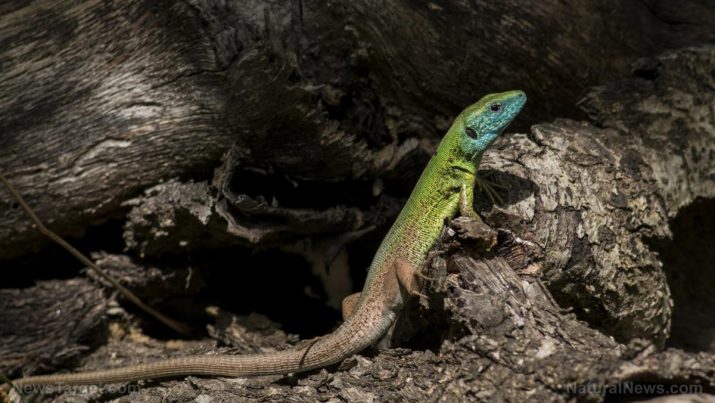
Industrial agriculture terrorizes Borneo: Palm oil plantations are responsible for deforestation, fires, habitat loss, air pollution
Wednesday, October 25, 2017 by Frances Bloomfield
http://www.realsciencenews.com/2017-10-25-industrial-agriculture-terrorizes-borneo-palm-oil-plantations-are-responsible-for-deforestation-fires-habitat-loss-air-pollution.html

Palm oil plantations may have brought revenue into the country, but they’ve caused a multitude of problems of well. From fire-induced deforestation to shrunken orangutan populations, the environmental impact of palm oil plantations is nothing short of overwhelming. Yet a small team of researchers from the Stability of Altered Forest Ecosystems (SAFE) project has revealed another consequence that no one could have seen coming: a rash of gigantic lizards skulking about land-disturbed areas.
In an article published on DailyMail.co.uk, researcher Joshua P. Twining explains that he and his colleagues uncovered this disturbing fact while conducting a study on Borneo’s scavenger communities. “Scavengers are an important but often overlooked group in understanding how ecosystems function. They provide vital services including the removal of carrion, which is a crucial component in recycling nutrients and preventing disease. And disruption of these groups has possible far-reaching implications,” Twining writes.
For their study, the researchers designed and laid out baited traps along various sites: some were within virgin jungle areas, others in logged forests, and even more near oil palms. They caught 118 different animals overall, with the most common being the Southeast Asian water monitor (Varanus salvator macromaculatus) and the Malay civet (Viverra tangalunga).
Twining and his colleagues notes that Southeast Asian water monitors, also known as water monitors, are increasingly prevalent in disturbed areas such as the palm oil plantations. Conversely, their numbers appeared to decrease as the researchers moved deeper into the forests.
“In fact, the Malay civet was the only native mammal recorded alongside water monitors in oil palms at all, and even this species preferred higher quality forest sites,” Twining says, then adds: “Of Borneo’s large native scavengers, they are the only species that has successfully adapted to the plantations.”
Considering how Southeast Asian water monitors are built, it’s no wonder that they can thrive where other animals can’t. For one, they can eat almost anything that can fit within their stomachs. Frogs, fish, crabs, snakes, rodents, and even other water monitors are all fair game to them. They can even devour carrion with little issue. These have no qualms about consuming human refuse either, as observed by the researchers, who found water monitors that had eaten instant noodle wrappers.
For another, palm oil plantations are near inhospitable for mammal scavengers and predators like sun bears (Helarctos malayanus), smooth-coated otters (Lutrogale perspicillata), and Malay civets. These mammals are unable to adapt to the lack of shade and diminished plant diversity, while Southeast Asian water monitors don’t mind the heat and can easily live off of human refuse. Moreover, the constant and rich food supply can allow water monitors to grow in both population number and size.
“A landscape filled with roaming giant lizards soon becomes a battle arena,” says Twining, who elaborates that Southeast Asian water monitors would settle their dispute by standing on their hind legs then wrestling, biting, and clawing at each other until one of them submits. “This ‘survival of the toughest’ is what drove the males of the species to reach such formidable sizes.”
Yet despite it all, the palm oil plantations have been deemed “ecological traps” by the researchers. Readily available food could entail a greater ratio of male to female water monitors, resulting in more fights that put male water monitors at risk of serious injury and increased energy expenditure. The higher densities of Southeast Asian water monitors could also boost the chances of adult members of the species cannibalizing the juveniles. Even though the animals seem healthy at the moment, there remains the possibility that the researchers’ predictions may become the reality.
Twining concludes: “Of Borneo’s large native scavengers, they are the only species that has successfully adapted to the plantations. But, in the long run, due to the culmination of adverse effects, water monitors may be doomed to the same fate as the bears and other mammals that once inhabited the space now dominated by oil palms.” (Related: Shocking: Orangutans to be extinct in just 10 years?)
And if hardy scavengers like the Southeast Asian water monitor aren’t exempt from the negative environmental impacts of industrial agriculture, what more the weaker animal species of Borneo? Moreover, who’s to say that these effects won’t soon be felt by the nation’s human population? The way things are going, it’s only a matter of time until it all comes to a head.
Visit Environ.news for more stories concerning our environment.
Sources include:
Tagged Under: Tags: animals, Borneo, deforestation, Ecology, environmental destruction, palm oil, palm oil plantations, Southeast Asian water monitors





